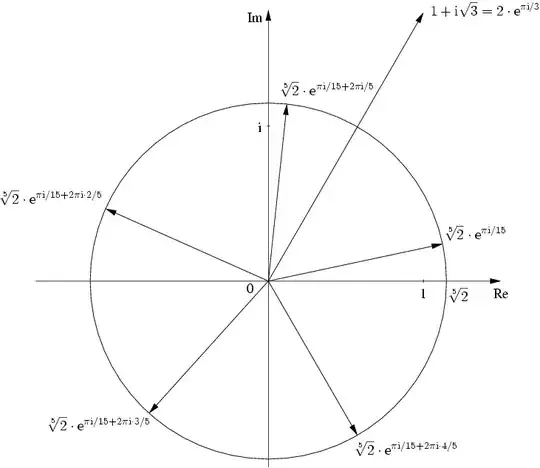Which one is the right way?
$$(-1)^{\frac32}=(-1)^{1+\frac12}=-1\times \sqrt{-1}=-i$$
Or,
$$(-1)^{\frac32}= \left((-1)^{\frac12}\right)^{3}= i^3=-i$$
Or,
$$(-1)^{\frac32}=\left((-1)^3\right)^{\frac12}=\sqrt{-1}=i$$
Which one is the right way?
$$(-1)^{\frac32}=(-1)^{1+\frac12}=-1\times \sqrt{-1}=-i$$
Or,
$$(-1)^{\frac32}= \left((-1)^{\frac12}\right)^{3}= i^3=-i$$
Or,
$$(-1)^{\frac32}=\left((-1)^3\right)^{\frac12}=\sqrt{-1}=i$$
All are equally right or wrong. Exponentiation is multi-valued unless the base is a positive real, or the exponent is an integer.
As such you can only expect the usual power rules to work under the interpretation that one of the valid values of each side of the identity will be a valid value for the other.
Going by the best definition we have for this case, $$ a^b = \exp(b\cdot \log a) $$ we find that the principal value of $(-1)^{3/2}$ is $\exp(3\pi i/2)=-i$, because the principal logarithm of $-1$ is $\pi i$ rather than $-\pi i$.
Extending exponentiation to complex numbers results in the problem that you'll have to select which branch to use since solving the equation $z^n = a$ has multiple solutions.
If you keep in mind that you have to stay on the branch all the identities will still hold, but the fault (like you do) is often that this is forgotten.
In this sense you will have to start with knowing how you get to $-1$. You must have a path from a positive real number that doesn't cross the origin that ends up at $-1$, depending on that path $-1^{3/2}$ can take two different values ($i$ or $-i$).
From the first calculation one would assume that you've taken the counter clockwise path around the origin, this will result in $-1^{3/2}=-i$. Along that path you will get $\sqrt{-1}=i$ and your result is correct.
The second is the same.
But for the third, you'll get $-1^3=-1$ which the RHS is reached by going one and a half rounds round origin counter clockwise. With that path $\sqrt{-1}$ is no longer $i$, it's in fact $-i$. So the result would be $-i$ for this case as well.
On the other hand if you went clockwise to the first $-1$ you would get the third result that you indicated, but then you've got another path and you would get the same result for the first two calculations as well.
Note that this extension also applies to the positive real numbers as well. It's just that when not having complex numbers there's no way of getting this ambiguity by reaching the number along another path.
Using the following rules, with $a,b \in \mathbb{R}$:
$$(-1)^{\frac{3}{2}}=$$ $$\left|(-1)^{\frac{3}{2}}\right|e^{\arg\left((-1)^{\frac{3}{2}}\right)i}=$$ $$\left|-1\right|^{\frac{3}{2}}e^{\arg\left((-1)^{\frac{3}{2}}\right)i}=$$ $$1^{\frac{3}{2}}e^{\arg\left((-1)^{\frac{3}{2}}\right)i}=$$ $$e^{\arg\left((-1)^{\frac{3}{2}}\right)i}=$$ $$e^{\tan^{-1}\left(\cos\left(\frac{3\pi}{2}\right),\sin\left(\frac{3\pi}{2}\right)\right)i}=$$ $$e^{\tan^{-1}\left(0,-1\right)i}=$$ $$e^{-\frac{\pi}{2}i}=$$ $$\cos\left(-\frac{\pi}{2}\right)+\sin\left(-\frac{\pi}{2}\right)i=$$ $$0+(-1)i=$$ $$(-1)i=-i$$
Keep in mind the four quad-roots of 1: 1, -1, i and -i. Any of these, raised to the fourth power, equals 1.
If you haven't encountered the complex plane yet, it will make visualizing these types of relations much much easier. Just like the number line did when you first started learning negative numbers.
Plot a number on the complex plane, determine the counterclockwise angle from the x axis (the positive real axis) to the number you've plotted—don't actually measure the angle, but observe it—divide that angle by whatever root you're taking (3rd root -> divide the angle by 3) and you have the angle of ONE of the answers. Draw a ray from the origin through that angle, and then two other rays making for a 3-symmetrical design, and you have the angles of the other two answers.
Here is an image for fifth roots. For the purposes of understanding my description of the visualization process, the numbers on the diagram are unimportant. 